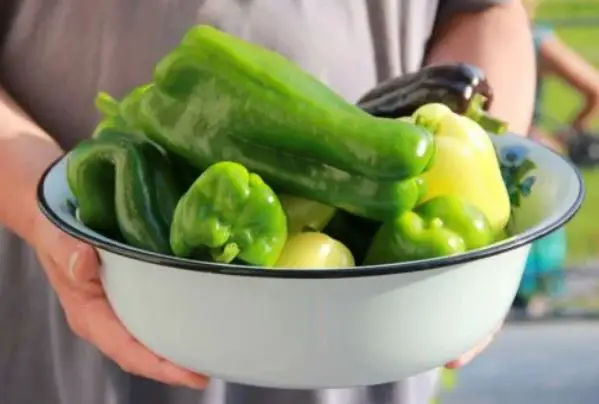The pepper is a plant sensitive to cold. Find out what you must do to be successful and be able to reap its fruits at home, at your fingertips.

Planting peppers at home is a way of being in harmony with nature, so you will choose not to use chemicals in the cultivation. You will get good results, as long as you respect some basic principles.
The first thing to keep in mind is that the most important thing for this plant is to reduce the risk of pests. In the same way, do not forget that the pepper needs significant amounts of nutrients and heat.
Materials for planting peppers at home
Since there is a great variety of pepper seeds that differ in size, pigmentation and flavor, you can buy the type that you like best to season and accompany your dishes.
This is what you need to grow them in your home:
Bell pepper seeds of your choice.
Substrate for seedlings.
Seedbeds.
Electric germinator (optional).
Hoe.
Porrón (optional) of about 15 liters of capacity and about 60 centimeters in circumference.
Step by step to plant peppers at home
The pepper is a cold sensitive plant that should be sown outdoors until well into spring. With this, you reduce the risk that the icy winds will end up ruining your crop.

Growing your own peppers will allow you to have one more ingredient for the kitchen at home and on hand.
1. Get a heated hotbed
In places where the temperature is below 26 degrees Celsius, the use of a heated germinator is recommended. It must be placed inside the house, near a window that receives sun.
With this, you will be protecting the pepper seeds from the cold and advance the season. If you live in a warm area, use a conventional seedbed.
2. Start sowing
Pour the substrate or fertilized soil into the seedbed and proceed to introduce 3 or 4 seeds to a depth of 2-3 millimeters per seedbed. Water with clean water until the plant germinates, and then choose only the most robust and largest.
Also, avoid putting the seeds too close. Otherwise, you will encourage the development of weak plants that will not thrive.
3. The sun is the best ally
After 8 to 20 days after sowing, you will see that the pepper seedlings begin to germinate. At this point, the sun’s rays and ventilation are essential to obtain good quality fruits. The pepper plant needs daily lighting.
4. Transplant
When the first two leaves appear and the stem begins to grow stronger, it is time to consider transplanting to a good size pot or to your garden plot, if you have one. Before this step you should make sure to enrich the soil with compost or compost.
In case of choosing a garden as a new home for your plant, make sure that the new soil for the pepper has a temperature of 18 degrees Celsius. If not, the pepper seedling may perish.
5. Leave space between them
Once your pepper plants have reached 15 centimeters in height or more, with 5 or 6 leaves on the stem, you should make sure that they have a separation of 40 to 50 centimeters between them. This way, they will have enough space to develop. In case they are planted in a pot, it is recommended one for each plant.
6. Water with measure
Excess water is harmful to many plants and pepper is no exception. This is because the layers of this vital liquid end up rotting the root, causing suffocation in compacted areas.
So, although it is true that you must make sure that your plant stays humid, it is also true that you must check that it has good drainage to avoid puddles.
7. Wait and then collect
Once you have followed these steps, all you have to do is wait for the fruits to sprout and for them to be of sufficient size and maturity to collect them manually.
Physicochemical conditions and tips for planting peppers at home
If you want to plant your own peppers, keep in mind that this plant will demand nutrients, sun and watering. Keep reading to find out more details about the home growing of this variety.
They need a place that gets a lot of sunlight
At least 6 hours a day of sunlight is ideal. The appropriate temperature for a good germination, flowering and subsequent cultivation ranges between 20 and 26 degrees Celsius.
In case the temperature varies significantly at night, you should use a thermal blanket that will help you retain heat during cold hours, as well as protect the plant from rain and possible predators. When summer arrives you can take it outside, either in a pot or to your garden.
You must cover their demand for nutrients
Solanaceae are plants that require nutrients to bear good fruit. Potassium is an element that cannot be lacking in your fertilizer, so incorporating comfrey leaves can raise its levels.
In addition, you must bear in mind that the absorption of this mineral will be essential to determine the pigmentation and quality of the fruits, so its demand will gradually increase until flowering.
In the same way, nitrogen is a very relevant component during the first stages of the crop, but unlike potassium, its demand falls after the first fruits are harvested. Keep in mind that planting the plant in a land that previously grew peas is a good idea to cover the need for nitrogen.
Thus, phosphorus, sulfur and magnesium must be part of the fertilizer, so fertilizers in the form of soluble solids and liquids are recommended.

Peppers require a lot of nutrients, so having a good compost or well-made compost is key to the process.
Take into account the pH of the soil
Despite the fact that this crop usually withstands acidity conditions of up to 5.5 and in sandy soils a pH close to 8, it is recommended that you measure the pH of the soil, taking into account that the optimal values should be between 6.5 and 7.
Carbonated water is a good option
Make sure the substrate is well drained, airy, and fluffy. Keep in mind that the soil should feel damp to the touch.
Although another way to know if your plant requires water is to look at the leaves; If they look dull and the ground is dry, you probably need water.
Carbonated water serves to replace the use of nitric acid. In addition, it provides the soil of your crop with the necessary acidification and, in unison, facilitates the solubility and correct absorption of nutrients.
In a summer with intense sun it is recommended to water the plant generously daily. Otherwise, every 2 or 3 days. Carbonated water can also be interspersed with natural water.
Planting peppers at home chemical-free
By planting your own peppers you can get chemical-free fruit. So if you decide to plant in a pot, put stones at the base and then sand to control humidity. In the same way, before transplanting or taking the pot out to the garden, it is recommended to acclimatize it, gradually exposing it to the external climate.
Likewise, the use of toothpicks or wooden posts is a good idea to keep your plant upright. This, in turn, favors ventilation and light. Another practice that can help your plant is pruning, which strengthens the thickness of the stem, optimizes air circulation and improves fruit quality. There are many ways of pruning that can be applied, but it is enough to remove the parts of the plant that are not so vital.
The pepper can be a neighbor of garlic and cabbage, since they get along very well. However, in no way can it be associated with cucumber or share space with fennel and kohlrabi.





